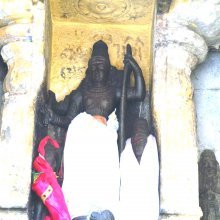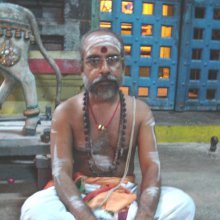Tretayuga, Treta-yuga, Tretāyuga: 15 definitions
Introduction:
Tretayuga means something in Buddhism, Pali, Hinduism, Sanskrit, the history of ancient India. If you want to know the exact meaning, history, etymology or English translation of this term then check out the descriptions on this page. Add your comment or reference to a book if you want to contribute to this summary article.
Images (photo gallery)
In Hinduism
Vaishnavism (Vaishava dharma)
Source: VedaBase: Śrīmad Bhāgavatam 9.14.49In the next yuga, Tretā-yuga, the performance of yajña began (tretāyāṃ yajato mukhaiḥ). Ritualistic ceremonies are generally called fruitive activities. In Tretā-yuga, beginning in the Svāyambhuva-manvantara, ritualistic fruitive activities were similarly manifested from Priyavrata, etc.
Source: ISKCON Press: GlossaryTretāyuga (त्रेतायुग).—The second in the cycle of the four ages of the universe or mahāyuga. It lasts 1,296,000 years. In this age Lord Rāmacandra appeared.
Source: Pure Bhakti: Bhagavad-gita (4th edition)Tretāyuga (त्रेतायुग) refers to “second of the four yugas: Satya, Tretā, Dvāparā and Kali”. (cf. Glossary page from Śrīmad-Bhagavad-Gītā).

Vaishnava (वैष्णव, vaiṣṇava) or vaishnavism (vaiṣṇavism) represents a tradition of Hinduism worshipping Vishnu as the supreme Lord. Similar to the Shaktism and Shaivism traditions, Vaishnavism also developed as an individual movement, famous for its exposition of the dashavatara (‘ten avatars of Vishnu’).
Purana and Itihasa (epic history)
Source: archive.org: Puranic EncyclopediaTretāyuga (त्रेतायुग).—Second of the four yugas. Kṛtayuga, Tretāyuga, Dvāparayuga, and Kaliyuga are the four yugas. There are three thousand deva-varṣas (divine years) in Tretāyuga.
Śrī Rāma was born at the end of Tretāyuga. Tretāyuga came to an end in B.C. 867100. Śrī Rāma ruled the country for eleven thousand years.
"daśa-varṣa-sahasrāṇi daśa-varṣa-śatāni ca / rāmo rājyamupāsitvā brahmalokam prayāsyati //" (vālmīki rāmāyaṇa).
(After serving his land for ten thousand years and another ten hundred years (ten thousand plus thousand years) Śrī Rāma will go to Brahmaloka). When Rāma took over the reins of administration he was only forty years old. See under Manvantara and yuga. (Classical Sanskrit Literature).
Source: archive.org: Nilamata Purana: a cultural and literary studyTretāyuga (त्रेतायुग) refers to a time period consisting of three times the amount of one Kaliyuga, according to the Nīlamatapurāṇa. The passage of the sun through one sign of the zodiac, we are informed, is called a solar month. Two months make a season, three seasons an Ayana and two Ayanas a year. Four lacs and thirty two thousand years make Kaliyuga. Twice as much as Kaliyuga is Dvāpara, thrice is Tretā and four yugas make one Caturyuga and seventy one Caturyugas make one Manvantara.
Source: Cologne Digital Sanskrit Dictionaries: The Purana IndexTretāyuga (त्रेतायुग).—Forms of Hari worshipped in the Yuga.1 Hari in the form of Yajña revealed the Vedas;2 characteristics of the Yuga;3 Duration of; Śrauta and Smārta dharmas begin to be observed: duties of kings in;4 origin of culture in;5 see Tretā.
- 1) Bhāgavata-purāṇa V. 17. 12; IX. 10. 52; 14. 43; XI. 5. 24-6.
- 2) Bhāgavata-purāṇa XI. 17. 12.
- 3) Brahmāṇḍa-purāṇa II 7. 21, 59; Bhāgavata-purāṇa XII. 2. 39; 3. 20-21, 28 and 52. Vāyu-purāṇa 8. 65-96; 99. 439-444.
- 4) Matsya-purāṇa 142. 17, 23-5, 40-77; 165. 6.
- 5) Vāyu-purāṇa 8. 146-178.

The Purana (पुराण, purāṇas) refers to Sanskrit literature preserving ancient India’s vast cultural history, including historical legends, religious ceremonies, various arts and sciences. The eighteen mahapuranas total over 400,000 shlokas (metrical couplets) and date to at least several centuries BCE.
Shaktism (Shakta philosophy)
Source: Google Books: ManthanabhairavatantramTretāyuga (त्रेतायुग) or Tretā refers to the age associated with Jālandhara, one of the sacred seats (pīṭha), according to the Manthānabhairavatantra, a vast sprawling work that belongs to a corpus of Tantric texts concerned with the worship of the goddess Kubjikā.—The Kumārikākhaṇḍa displays most of the many new developments that took place after the revelation of the Kubjikāmatatantra including those concerning the sacred seats. [...] Although the seats are the same five described in the Kubjikāmatatantra and its expansions, their contents [i.e., the Tretāyuga] and the beings who inhabit them are quite different.

Shakta (शाक्त, śākta) or Shaktism (śāktism) represents a tradition of Hinduism where the Goddess (Devi) is revered and worshipped. Shakta literature includes a range of scriptures, including various Agamas and Tantras, although its roots may be traced back to the Vedas.
General definition (in Hinduism)
Source: WikiPedia: HinduismTreta Yuga (त्रेता युग) is the second out of four yugas, or ages of mankind, in the religion of Hinduism. Treta means, third in Sanskrit. The first yuga is Satya Yuga of perfect morality and the one after Treta is the Dvapara Yuga. The most famous events in this yuga were Lord Vishnu's fifth, sixth and seventh incarnations as Vamana, Parashurama and Rama respectively. The Dharma bull, which symbolises morality, stood on three legs during this period. It had all four in the Satya Yuga and two in the later Dvapara Yuga. Currently, in the immoral age of Kali, it stands on one leg. The Treta Yuga lasted 1,296,000 years.
In Buddhism
General definition (in Buddhism)
Source: Wisdom Library: Dharma-samgrahaTretāyuga (त्रेतायुग) or simply Tretā refers to the “threefold-life age” and represents the second of the “four ages” (yuga) as defined in the Dharma-saṃgraha (section 88). The Dharma-samgraha (Dharmasangraha) is an extensive glossary of Buddhist technical terms in Sanskrit (e.g., tretā-yuga). The work is attributed to Nagarjuna who lived around the 2nd century A.D.
India history and geography
Source: archive.org: South Indian FestivitiesThe tretayuga refers to the second of the four yugas.—The anniversary of the first day of the Treta-yuga falls on the ninth lunar day in the bright half of Karttika (October-November); the incarnations in this age were the Vamana or Dwarf, Parasurama and Rama.

The history of India traces the identification of countries, villages, towns and other regions of India, as well as mythology, zoology, royal dynasties, rulers, tribes, local festivities and traditions and regional languages. Ancient India enjoyed religious freedom and encourages the path of Dharma, a concept common to Buddhism, Hinduism, and Jainism.
Languages of India and abroad
Sanskrit dictionary
Source: Cologne Digital Sanskrit Dictionaries: Shabda-Sagara Sanskrit-English DictionaryTretāyuga (त्रेतायुग).—n.
(-gaṃ) The second or Treta age. E. tretā, and yuga age.
Source: Cologne Digital Sanskrit Dictionaries: Monier-Williams Sanskrit-English DictionaryTretāyuga (त्रेतायुग):—[=tretā-yuga] [from tretā] n. the T° age, [Mahābhārata etc.]
Source: Cologne Digital Sanskrit Dictionaries: Yates Sanskrit-English DictionaryTretāyuga (त्रेतायुग):—[tretā-yuga] (gaṃ) 1. n. The second age.
[Sanskrit to German]
Sanskrit, also spelled संस्कृतम् (saṃskṛtam), is an ancient language of India commonly seen as the grandmother of the Indo-European language family (even English!). Closely allied with Prakrit and Pali, Sanskrit is more exhaustive in both grammar and terms and has the most extensive collection of literature in the world, greatly surpassing its sister-languages Greek and Latin.
Kannada-English dictionary
Source: Alar: Kannada-English corpusTrētāyuga (ತ್ರೇತಾಯುಗ):—[noun] = ತ್ರೇತೆ - [trete -] 3.
Kannada is a Dravidian language (as opposed to the Indo-European language family) mainly spoken in the southwestern region of India.
See also (Relevant definitions)
Full-text (+75): Treta, Agnayi, Yuga, Rama, Jambavat, Visarjika, Parashurama, Dashavatara, Kaliyuga, Gramyapashu, Harishcandra, Vamana, Tapasya, Shridhara, Agama, Caturyuga, Four Ages, Kharva, Tankadhari, Karandhama.
Relevant text
Search found 67 books and stories containing Tretayuga, Treta-yuga, Tretāyuga, Tretā-yuga, Trētāyuga; (plurals include: Tretayugas, yugas, Tretāyugas, Trētāyugas). You can also click to the full overview containing English textual excerpts. Below are direct links for the most relevant articles:
Song 15 < [Paugaṇḍa-līlā (Ages 6-10—Pastimes)]
Song 7 < [Grantharambha (the book begins)]
Song 12 < [Grantharambha (the book begins)]
The Skanda Purana (by G. V. Tagare)
Chapter 19 - Incarnations of Śrī Viṣṇu < [Section 1 - Prabhāsa-kṣetra-māhātmya]
Chapter 20 - Creation of the Moon < [Section 1 - Prabhāsa-kṣetra-māhātmya]
Chapter 3 - Principal Holy Places in Vastrāpatha < [Section 2 - Vastrāpatha-kṣetra-māhātmya]
Garga Samhita (English) (by Danavir Goswami)
Verse 1.4.35 < [Chapter 4 - Description of Questions About the Lord’s Appearance]
Verse 5.10.4 < [Chapter 10 - The Stories of the Washerman, Weaver, and Florist]
Chaitanya Bhagavata (by Bhumipati Dāsa)
Verse 1.2.168 < [Chapter 2 - The Lord’s Appearance]
Verse 1.5.170-172 < [Chapter 5 - Eating the Mendicant Brāhmaṇa’s Offerings]
Verse 1.2.167 < [Chapter 2 - The Lord’s Appearance]
Related products


